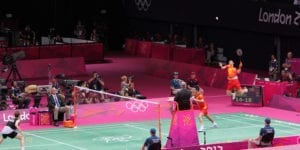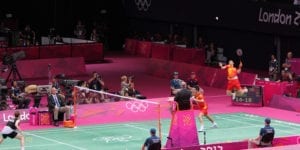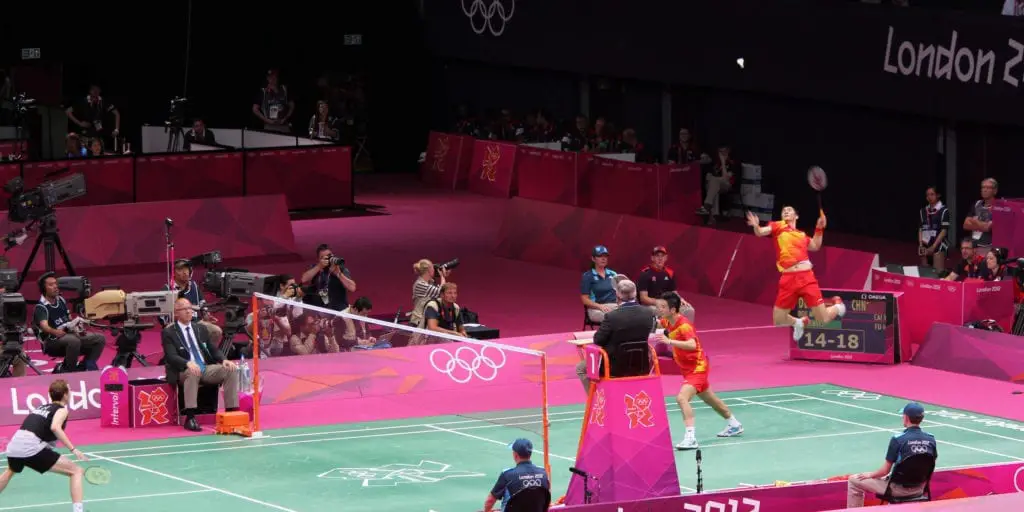In badminton, doubles is the fastest paced sport. It has so many different aspects that it could potentially even be considered as a different game than badminton singles!
In this article, I will show you multiple tips and tricks for playing doubles as well as mixed doubles.

Doubles Attacking Tactics
Attacking in doubles is intense. It’s all about who can change the pace the best and throw your opponents off guard.
Unlike singles, which tends to be a slower paced game, doubles is full of flashy fast shots and keeping the shuttle low. If you’re able to drive your opponents back and start angling the shuttle down, you will force them to play lifts. If you play very tight net shots, your opponent will also be forced to lift. Once they’re forced to lift, heavy smashes or fast slices can be performed on the offensive. Find the angles and force your opponents to lift. When they lift, you’ll be on the attack.
Before we get into specific shots you should play, let’s discuss a little about positioning. In doubles, the positioning for attacking is front and back. For mixed doubles, the girl should be at the front (unless you have the rare case where the girl hits harder than the guy then any front and back position works). This position is optimal because you want the back players to smash or play quick drops to end the rally or set up for the front player. The front player shouldn’t stand right at the net but closer to the middle and they should try to intercept and kill any shuttles that they can get.
One tip for doubles is to try and target down one person on defense. This is especially effective in mixed doubles since the girl’s defense and strength usually isn’t as good as the guy. Although, you and your partner need to make that judgement depending on what you see in your rallies but generally start off by attacking the girl. If you manage to force the person out of position from targeting them, you will be able to end the rally. Plus, it attacks them psychologically which I’ll talk about some other time.

When attacking, the back player should also keep his or her shots as steep and fast as possible. You’ll usually be playing full power smashes at the back, but it’s always good to occasionally change it up with a half-smash or slice. It’ll catch your opponent off guard by changing the rhythm which will make them more prone to making mistakes. Hitting down the middle in doubles is also more effective compared to singles. Hitting down the middle will test the opponent pair’s communication with each other on who’s hitting the shot.
The only thing at the back you shouldn’t usually play are cross-court smashes. Although, there are certain times like if your opponent is mispositioned, the cross court smash is generally too slow, and your opponent can block it most of the time.
At the front, it’s all about trying to intercept and kill or forcing them to lift again. Your racket should be held up high, and you should be ready to net kill. Occasionally you might move into the back to start smashing, but we’ll work through that in the rotation section.
Doubles Defensive Tactics
Defense in doubles is a lot different than singles defense. You’re not trying to block it close to the front anymore, it runs the risk of the front player net killing. Lifting smashes is what you’re going to do the most.
Before we get more into specific shots to play while on the defense, let’s get into positioning. The most optimal position for defense is side to side. Stay low to the ground and keep your racket up.
A little more specifics about side to side defense is you generally want to stay closer to the side that the opponent is going to smash straight. This will allow you to react faster. Leaving the cross side a little more open is okay because cross smashes will always be slower than straight smashes so you’ll have equal times to get to each smash.
Now that you’re in position, how do you actually block the smash? Like I mentioned above, doing a traditional block to the front will run the risk of the opponent front player net killing so playing lifts is a strategy that you’ll probably use. Defense in doubles is basically a waiting game. You’re trying to wait for the opponent to make a mistake, so the best thing to do is calm down and lift as far back and high as possible to tire and frustrate your opponent.
Also, try to keep your lifts close to the corners. If you lift to the middle, the opponent can smash anywhere on the court, so you lose the ability to anticipate where your opponent is smashing.
When the opportunity comes, and the opponent makes a mistake, here’s when you can turn it around. If the offensive shot is too high above the net, you can start attacking by driving the shuttle forward.
Another tip for defense is making your opponent move at the back. Cross court lift or push the shuttle straight if the opponent cross smashes. This way you force your opponent to run more, and if they’re too slow, they have to play a clear thus giving your team the offense.
These tactics apply to all offensive shots like half smashes, drops, etc. Be ready!
Rotation
I hinted at rotation in the attacking tactics section. Rotation in doubles is extremely important especially if you want to play at a higher level.
The most basic rotations are based on reaction. Watch your opponent’s and where they hit the shuttle and then move spontaneously. If the opponent hits the shuttle below the waist, go into attack position, if they hit above the waist, go into a more defensive position. Some communication will definitely be needed.
To go into an attack position from a defensive position, either you or your partner needs to move forward. Then the other partner takes the back and prepares to smash. To go into a defensive position from an attack position, the front person needs to move back into either the left or right side, and the back person should react and cover the other open area. It takes lots of practice and good communication with your partner to get this really good.

There’s one more rotation that I like to cover is one I’d like to call maintaining the attack position. Sometimes your partner at the back can get tired from smashing or often times, the opponent might make a quick stroke and play a flatter lift cross court. Instead of letting your partner clear the shuttle and give your opponent the offense, it’s good to cut it off and rotate to the back if you can.
Here’s what I mean. If you are the front player and see a flat lift coming, start positioning yourself more towards the back and prepare to smash it down. Intercepting it early will also catch your opponent off guard and break down their defense. When your partner sees you going for the shuttle, they should move to the front and be ready to intercept and kill.
A tip for people that don’t have the same partner all the time. In this case, you should just cover what areas your partner is not covering. That’ll make sure your court doesn’t have any significant flaws.
These are the basic rotation strategies, but they can be impossible to pull off without the right communication.
Communication
Like everything in the world that involves a team, communication is vital. It’s tough to do much without the right communication. Bad communication can cause collisions with each other or rackets hitting each other and breaking. It happens pretty often, even in professional play!
Before starting a game, in between points, in between sets, whatever time you can find, try to use it and talk to your partner about strategies. What you want to do and what your partner wants to do. What you see in your opponent’s weaknesses. Doubles pairs who do that have a significant advantage.
One strategy that you definitely need to communicate to your partner is how you’re going to serve. Whether it’s with hand signals or telling them before, if they know how you’re going to serve, they know what they’re supposed to do. For example, if you flick, your partner needs to be ready in case the opponent smashes the flick. If you don’t tell your partner, they’re not going to be prepared and fail to receive whatever comes down.
Talking to each other also boosts focus and morale of the pair. Don’t stop talking to your partner. It’s always good to tell your partner nice shot after they win a point, give them a pat on the back, and tell them don’t worry when they mess up. Not saying anything is just as bad as telling them that they’re bad and messed up. Both of you will lose focus and end up losing the game if you don’t encourage each other.
Conclusion – Find Some Friends
Playing doubles happens lots at a recreational level. Community gyms and drop in badminton centers always have a surplus of people so playing doubles often times is a rule that you have to follow. It can also be lots more fun including more people! Find a group of four or more, and you can play a variety of games.
That’s it for today, if you have any questions or comments, feel free to leave them down below and have a great day! What’s your favorite badminton game mode, mixed doubles, singles, or doubles?

